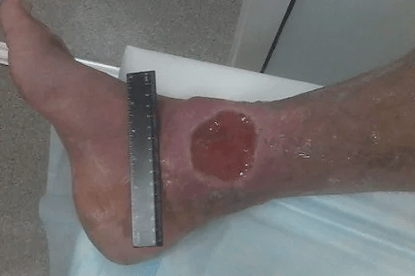
Varicose veins - This is the expansion of subcutaneous veins in diameter more than 3 mm.Varicose veins are developed due to the weakened operation of the ventilati and the weakness of the venous wall;At the same time, the outflow of blood from the lower extremities, increasing pressure inside the veins, which can lead to chronic venous insufficiency.
Sometimes Telanggiectasia and Reticular veins die for Varicose-Open.
These are veins in diameter 3 mm and less, They do not affect the venous drain, but cause a clear cosmetic breakdown.
What is the prevalence of varicose veins?
The varicose spread of subcutaneous veins is present in 30% of women and in 15% mature men.The prevalence of varicose veins of the lower extremities is multicolored and present in most people over 60 years of age.The share of patients with trophic disorders in adulthood is only 1.8%, while in the age indicator reaches 20%.At the same time, each fifth patient in life is facing thrombophlebitis.Among the reasons leading to disabilities, the share of the disabled forms of veins is more than the arteries.
The main risk factors for varicose veins development are:
- Age
- Feminine
- pregnancy
- Hormonal disorders
- Positive family history
Additional risk factors:
- smoking
- Arterial hypertension
- constipation
Literature on additional risk factors is contradictory.Moreover, the risk of developing a venous disease is low.
How are varicose veins manifest?

The most common manifestation is an unevenly expanded vein protruding above the surface.In some cases they can be barely noticeable or determined by touching, in others take a winding form with the formation of nodes or appears reminiscent of a large bunch of grapes.
Often varicose veins follow the following symptoms:
- Feeling and tension in your legs
- Pulling pain and / or pain with veins
- Fast Fatigue Foot
- Itching skin
Rarely varicose disease can cause restless leg syndrome and night spasms.
What are the dangers of advancing varicose veins?
In the absence of treatment, the advancement of varicose veins can lead to chronic venous insufficiency (cvn).The presence of HVN indicates serious violations of the Lymphal Venice return (clinical classification), which includes: chronic edema (lymphedema), skin color (hyperpigmentation), venous eczema, skin, trophy venous ulcer.
What are the complications of varicose veins?
Thromboflebitis - The formation of thrombus in the surface venous system is an event that faces 20% of patients with varicose veins.Such thrombosis follows strong pain, skin redness, sealing along the veins on the lower leg and / or thigh.In the absence of treatment, thrombotic masses are a possible deep venous system.

Thrombosis of deep veins (TGV) - In most cases, the start of the process is asymptomatic.When the thrombosis spreads on the thigh segment and vein of the pelvis, the main drain of blood from the lower extremities, which accompanies the strong edema and the pain and syndrome is considered a life situation.
Thromboembolia of pulmonary arteries (bodies) - In 10% of cases, thrombotic masses in the deep veins of the lower extremities were fragmented and migrated to the pulmonary arteries with blood flow, causing death.
What is needed for the correct diagnosis?
Given the various forms of venous diseases, each detail of the patient's development history, the presence of simultaneous diseases, transactions, the result of an external doctor's examination and the most important ultrasound, ultrasound is to make a correct diagnosis.Today, the latter is the most actual and non-invasive method of studying the veins of the lower extremities.
Purification of varicose veins, most common methods:
- Medications for medication-vein treatment have proven their efficiency in reducing varicose vein symptoms, but are unable to eliminate varicose veins independently.Pharmacotherapy is successfully used to prevent complications in risk groups, preoperative preparation and postoperative rehabilitation.
- Compressed treatment - Carrying a special medical knitting in the form of golf, sock, tights.In some cases, a multi-purpose bend is used with elastic bandages of different extensions and hardware pneumos compression.The role of compression treatment is difficult to overestimate, present in almost every phase of prevention and treatment of chronic veins.
- Introduction to lumen veins of drugs that can cause its closure.This method is a gold standard for eliminating reticular veins.It is successfully used in the treatment of varicose veins not a large diameter and has limits in the removal of the pathological flow of the blood of the main subcutaneous veins.
- Classic surgery - Combined phlebectomy, in modern performance, is performed on an outpatient basis under spinal or local anesthesia.In some cases, this is the only feasible way when the target veins are very convincing and / or have high extensions.However, the method is inferior to Endo vascular traumatic procedures.
- Endo Venous Laser Prison - Method for the treatment of varicose veins, in which the vein does not remove, but is closed from the inside of laser radiation energy, which is brought directly into the vessel with a fiber.The efficiency of the procedure is comparable to the results of surgical removal of the vein, at the same time characterizes the minimum trauma.Rehabilitation time is 1-3 days.
- Radio frequency prison - Progressive way to remove pathological flow of blood venoms.This is a completely outpatient procedure made in local anesthesia.Treatment efficiency matches the level of classical phlebectomy, the pain syndrome is minimal or absent.Rehabilitation time is 1-2 days.












































